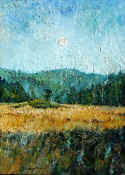The Q talks to Carl Baum
This
week we talk to Carl Baum, a friend from Palo Alto in California who attends Saraha
Center in San Francisco and, when in Florida, Kancha Center in Sarasota.
When
were you first attracted to Buddhism?
About six years ago when Geshe Kelsang
Gyatso came to San Francisco on a teaching tour of the West Coast.
What made
you choose to come to this Buddhist Center?
I had a ten day break from our
Foundation Program class at Saraha Center. I could think of nothing better than
to visit my family, and to come to the Kancha Center and be with my good friends
Nick and Lucy, whom I met at several Festivals, and now I could finally attend
some of their teachings!
Were you apprehensive about coming? What did you
expect?
Apprehensive? Just the contrary. Perfect delight! I expected the Center
to be filled with affectionate warmth and wisdom because of my acquaintance with
Nick and Lucy.
What do you like best about coming here?
Though Kancha
Center is only about two years old, it appears to be fully aglow with so much
enthusiasm, commitment, and warmth. Sunny Sarasota has a very sunny Center that
is blooming in such a short time! I guess the right elements have come together
to make it grow so quickly... with many blessings to water it!
How would you
explain the benefits of meditation to someone new?
Even if we are enjoying
a most fortunate rebirth as a human being living in excellent conditions, we soon
realize how much suffering is built into each life. We also begin to realize how
much suffering is everywhere. Meditation is our best opportunity to change our
life. For when we go within and mix our mind with virtuous objects, such as refuge,
affectionate love, great compassion, we are virtually changing everything that
is outside us. Step by step, we see a new and better world because of the changes
within! When we mix our mind like water with water, holding virtuous thoughts
in meditation, we begin to act virtuously as a conscious choice. We recognize
that our thoughts and actions create our karma, our very happiness or suffering.
So step by step, we transform our minds of anger, attachment, and ignorance into
a Bodhisattva's mind of great compassion and wisdom.
How has what you have
learned here made a difference in your everyday work and home life?
I am returning
to my Dharma Center in San Francisco with renewed energy and commitment as a student
of the Dharma. By seeing such a beautiful example of Sangha in Sarasota, I was
much touched by this thought: Geshe-la's inspiration and guidance is creating
a worldwide Sangha. Through his offering us such inspired and gifted teachers,
together with his eighteen books of commentary on the Dharma, we can travel near
and far and are always surrounded by the one Dharma and Sangha. And so eventually
we can find our Dharma Center everywhere!
What do you feel that Buddhism can
offer to the world today?
Our spiritual guide, Geshe-la and the NKT offers
us a perfect way to navigate from the Port of Suffering to the Port of Happiness
and Bliss. The Dharma gives us the map that's time-tested for over 2500 years
of such voyages. It shows us how we can change our lives. Our teachers' inform
and inspire us to open ourselves to that perfect map to happiness and the end
to our suffering. Then, if we develop real faith and effort we are told blessings
will constantly follow us on our path, like gentle winds that will fill the sails
of our tiny vessel, enabling us to reach our ultimate destination.
What is
your favorite Kadampa Buddhist quotation?
On the ground of equanimity,
Pour
the water of love,
And sow the seed of compassion.
From these the harvest
of bodhichitta will arise.
Je Tsongkhapa (AD 1357-1419)
What is your favorite
Dharma movie, and why?
Some movies are more Dharmic than others. 'The Matrix'
for one. But I am beginning to think that movies, like all of life, present a
depiction of virtue and non-virtue, happiness and suffering. Beyond the artistic
side, each movie is a study for us in how people are using their lives, whether
for better or worse. If our minds are clear and protected with some wisdom, we
can look with compassion at the suffering and rejoice with the temporary relief
from suffering called samsaric happiness! Perhaps, some movies help us grow in
terms of compassion and wisdom in showing us another way to look at a situation.
With which historical Kadampa Buddhist practitioner do you most identify,
and why?
Geshe Langri Tangpa (AD 1054-1123). He won my heart when I read the
story of how he reacted to protect the mother and the sick child before a teaching
audience of a thousand students. What wisdom and compassion! He cared not at all
for himself or what his students would say about his actions. He knew what needed
to be done. And not for a moment did he flinch. No ego, no personal pride, nothing
counted except to be of perfect service. It is hard to imagine anyone as skilled
in handling a most sensitive and extremely difficult circumstance. He is a true
hero of heroes! And in addition, we have his Eight Verses of Training the Mind,
and now a whole book about it from Geshe-la!
What aspect of the Bodhisattva's
way of life most inspires you?
The achievement of Bodhichitta carries so many
benefits for the Bodhisattva. I guess the idea that one then possesses a state
of mind that is the source of peace and happiness for all beings is most inspiring.
What's the first thing you're going to do when you become a Buddha?
Become
a manufacturer of 'Love Dust' and sprinkle it all over the world, especially in
the mouth of Babes... so no time is lost!
